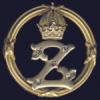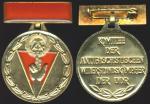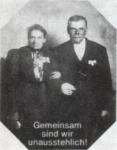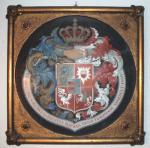-
Posts
1,628 -
Joined
-
Last visited
-
Days Won
2
Content Type
Profiles
Forums
Blogs
Gallery
Events
Store
Everything posted by speedytop
-

DDR Fighter Against Fascism - group
speedytop replied to kimj's topic in Germany: Post 1945: Bundesrepublik & DDR
Hi Kim, I can only say, that both medals in my collection are in such cases, with a pushbutton as with your case in the upper row. Yes, there is another medal, but not wearable. Regards Uwe -

DDR Fighter Against Fascism - group
speedytop replied to kimj's topic in Germany: Post 1945: Bundesrepublik & DDR
Gordon, the original signature on the document is from Otto Funke, the leader of the "Zentralleitung" (central administration) of this committee in Berlin. My medal was awarded 1977 to a former "Stabsfeldwebel" of the MfS. Kim, this medal must be changed with the "Ehrennadel der Organe der Rechtspflege" to the better case. Regards Uwe -

DDR Fighter Against Fascism - group
speedytop replied to kimj's topic in Germany: Post 1945: Bundesrepublik & DDR
Hi Kim, that is the source, Post 67: http://gmic.co.uk/index.php?showtopic=7707...60&start=60 And these are the regulations, on page 9 and 10: Regards Uwe -

Soviet Strange ribbon
speedytop replied to Bryan's topic in Russia: Soviet Orders, Medals & Decorations
Hi Marc, whatever you want: It was cut out, taken a photo by daylight (tomorrow), i can show you the cut edges. Regards Uwe -

Soviet Strange ribbon
speedytop replied to Bryan's topic in Russia: Soviet Orders, Medals & Decorations
Hi Christophe, here are some old men , and here are some very nice pieces in my collection, worldwide. Yes, that is mine. But the most interesting piece I have from the CCCP is a Lenin order type 3, variant 1 with abraded serial number. Kind Regards Uwe -

Soviet Strange ribbon
speedytop replied to Bryan's topic in Russia: Soviet Orders, Medals & Decorations
Hi, the picture in Post 4 is very small, and I cannot identify the colours. Is this such a bar, or is it from another period? Regards Uwe -
Hi George, Dem Herrn Kameraden Josef Deicker, Morbach f?r langj?hrige treue Mitgliedschaft im Kriegervereinswesen in Anerkennung und Dankbarkeit gewidmet. Berlin, den 3. Dezember 1932. Der Vorstand des preu?ischen Landes-Kriegerverbandes. (Unterschrift) General der Artillerie a.D., Pr?sident. rough translation To (Mr.) comrade Josef Deicker (in) Morbach dedicated in recognition and gratitude for long lasting membership in the veterans league. Berlin, the 3. December 1932. The board of directors of the prussian provincial veterans league. (signature) General of the artillery, retired, president. It is not Hindenburg's signature, he was the honorary president, but not the acting president. Regards Uwe
-
Hi, the thread in WAF is closed, therefore I can only post here. WAF, the member "max history" about the new member "beuchars" (here Davey?) after some comments: "Well that just about beats all?..everyone is wrong and I am somewhat blinkered!" I know this feeling, combined with my first comments about the originality of the German sports badges DRL without swastikas in WAF , later here in GMIC. But I could show in both forums (foras), that the others were really wrong. But "beuchars" (Davey) is essentially complete wrong. Like the comments from an other German in WAF, "FrankS", I can only say, that it is not really German, what you can see there printed below the signature from "Keitel" (Post 12). "Hoffmann A.G., Schreibwaren des F?hrers Sekret?riat neuen Reichskanzlei, Berlin W8" First, the word Sekret?riat is wrong (Sekretariat). When i try, to speak it, I want to say Sekret?ri?t, that is easier than Sekret?riat. And the word Sekret?r is not a problem, but Sekret?riat And second, there is no sense in the sentence/sequence. It could be: Hoffmann A.G., Schreibwaren; Sekretariat des F?hres Neue Reichskanzlei, Berlin W8 or: Hoffmann A.G., Schreibwaren; des F?hrers Sekretariat in der neuen Reichskanzlei, Berlin W8 But this is all nonsense, just as the nonsense on the card in Post 12. Max (max history) has already indicated all the other mistakes in the forum WAF. Regards Uwe
-

Does anyone know this medal?
speedytop replied to madness1313's topic in Germany: Weimar Republic & Deutsche Freikorps
Hi, German War Associations Ordensrat der Deutschen Ehrenlegion e.V. Orders Chancelory of the German Honor Legion Ritterkreuz der Deutschen Ehrenlegion Knights Cross of the German Honor Legion Source: Detlef Niemann, Price Guide Orders and Decorations Germany 1871-1945, Hamburg 2004 No. 2.02.18 c) Regards Uwe -

Austria-Hungary Austria (Republic 1918-38), Order of Merit
speedytop replied to lilo's topic in Austro-Hungarian Empire
Hi Lilo, first I want to express, that there is no differentiation between military and civil for this award, the colours are depending on the time-frame they were awarded and the degree of the decoration. That I want to show in my first post. Second, I think that there is something wrong about the name of the decoration. In 1931 an Austrian Order of Merit does not exist, and it is not a Grand Cross at that time. Once again: Ehrenzeichen f?r Verdienste um die Republik ?sterreich since 1934 ?sterreichischer Verdienstorden The correct name is in 1931: Ehrenzeichen f?r Verdienste um die Republik ?sterreich (Decoration for Merit to the Republic of Austria) And the correct degree at that time is not Grand Cross (Grosskreuz), it is: Grosses Ehrenzeichen am Bande (Grand Decoration w. Sash) The cross and the cross on the breast star are white enamelled. The colours of the sash are correct in Post 3 for the "Decoration for Merit to the Republic of Austria - Grand Decoration w. Sash". The colours of the ribbon on this website are wrong: <a href="http://www.pinetreeweb.com/bp-honours-austria.htm" target="_blank">http://www.pinetreeweb.com/bp-honours-austria.htm</a> That is my opinion. Regards Uwe -

Austria-Hungary Austria (Republic 1918-38), Order of Merit
speedytop replied to lilo's topic in Austro-Hungarian Empire
Hi Lilo, Ehrenzeichen f?r Verdienste um die Republik ?sterreich since 1934 ?sterreichischer Verdienstorden The left cross (golden, red enamelled) is: Goldenes Ehrenzeichen or Ritterkreuz 1. Klasse The right cross (silver, white enamelled, smaller than the golden cross) is: Silbernes Ehrenzeichen or Ritterkreuz Please see here: http://www.medals.lava.pl/at/at2.htm Compare the colours: 5th row, 5th decoration 6th row, 2nd decoration Regards Uwe -
Hi Jerome, an interesting picture. There are two pieces in my collection, belonging to this "event" First a watercolour in a golden frame, with the coat of arms of Schleswig-Holstein and a wording like that on your picture "Up ewig ungedeelt!" = Undivided forever! Second a cased medal for the veterans from Brunswick (Braunschweig), fighting in that war 1848/1849 for an undivided Schleswig and Holstein, awarded 1891. Reverse: Regards Uwe
-

Poland Grand Cross of the Order of Polonia Restituta
speedytop replied to Riley1965's topic in Central & Eastern European States
Hi Paul, please see here: http://klub.chip.pl/asnieg/index.html PRL picture (Tablica) 40 and Opis plansz Tablica 40 6. Krzyż Oficerski Orderu Odrodzenia Polski 4 kl. 4. class or officers cross (appr. 55mm), the 5. class is 44mm, 2. and 3. class 60mm, 1. class 68mm. Regards Uwe -
Hi Paul, sorry, I don't think, that I'm rude. I'm short and precise. And if I'm hostile, that looks completely different Hi Lilo, sorry, I want to help you, but I have no answer for these specialiced part of your question. But, when he was a recipient of this decoration in 1904, in peacetime, why should there be a decoration with swords in peace time? I can not follow your considerations. The swords are only for merits in a war. "Schwerter f?r Kriegsverdienst". The Grand Cross with swords and the Star with swords that I hold in my hands for cataloging, together with several other decorations, come from a high ranked German general with extraordinary war merits in WW I. Kind regards Uwe
-
Hi, Streckenbau. Does that make sense? Yes! (Bahn)Strecke = railway line "Eisenbahn Reg. 3, Streckenbaukol. 4" Streckenbaukolonne = a group building a railway line Streckenbaukolonne 4 beim Eisenbahnregiment 3 "b. s?chs. O.H.L., Fernspr.Stat.Zug 1151" Fernsprechstations-Zug 1151 bei der s?chsischen Obersten Heeresleitung Post 16: "Kommandant d. Gesteins-Bohrabt., Marsch.Gruppe 1" Gesteinsbohrer = rock drill Gesteinsbohrabteilung = detachment with the equipment for rock drilling Regards Uwe
-
Hi Kevin in Deva, "As an example Bavaria's colours were predominantly Blue and White for example." No, absolutely not! He lived 5 years in Bavaria, and such a mistake . The colours were White and Blue . http://en.wikipedia.org/wiki/Bavaria The White-And-Blue Heart-Shaped Shield" And that is important for the Bavarians. The colours of Pomerania (Pommern) were Blue and White. Regards Uwe Sorry KDVR, no further information about the dog tag, but I think, it is not a dog tag for a person, I see no correspondence with contemporary pieces.
-

Bundesrepublik BRD Luftwaffe "Ike" tunic
speedytop replied to Ed_Haynes's topic in Germany: Post 1945: Bundesrepublik & DDR
Gordon, please excuse, but you must not correct the use of KKB/KKBw markings. You could order and buy there complete tailored uniforms, not only the manufactured uniforms. You can compare KKB/KKBw with other shops as Rahne or Kuhnert etc. Regards Uwe -

Bundesrepublik BRD Luftwaffe "Ike" tunic
speedytop replied to Ed_Haynes's topic in Germany: Post 1945: Bundesrepublik & DDR
Hi, KKB is the abbreviation for the official military shop of the Bundeswehr for officers and some senior NCO's: Kleiderkasse der Bundeswehr Later (it changed in the sixties, but I don't know when) KKBw Kleiderkasse f?r die Bundeswehr now it is LHD: http://www.lhd-shop.de/Welcome.lhd Regards Uwe -

Bundesrepublik BRD Luftwaffe "Ike" tunic
speedytop replied to Ed_Haynes's topic in Germany: Post 1945: Bundesrepublik & DDR
Gordon, it started in 1962 with the rounded shoulderboards for all ranks and the coloured "underlay" for officers and generals. In red for generals, the other officer ranks in the the colours according to the branch of service (waffenfarbige Unterlage). Enlisted men and NCO's had a coloured piping (Paspel) around the shoulderboard, according to the branch of service. Is there a label inside the inner left breast pocket (look Post 3), that you can date your jacket, "updated" 1962? Regards Uwe -

Bundesrepublik BRD Luftwaffe "Ike" tunic
speedytop replied to Ed_Haynes's topic in Germany: Post 1945: Bundesrepublik & DDR
Hi Gordon, I do not know it, but the first uniforms are rare, particular from a general. Your shown shoulderboard is a later "updated" version, because there is the red underlay. The first shoulderboards had only the golden cord. Regards Uwe









